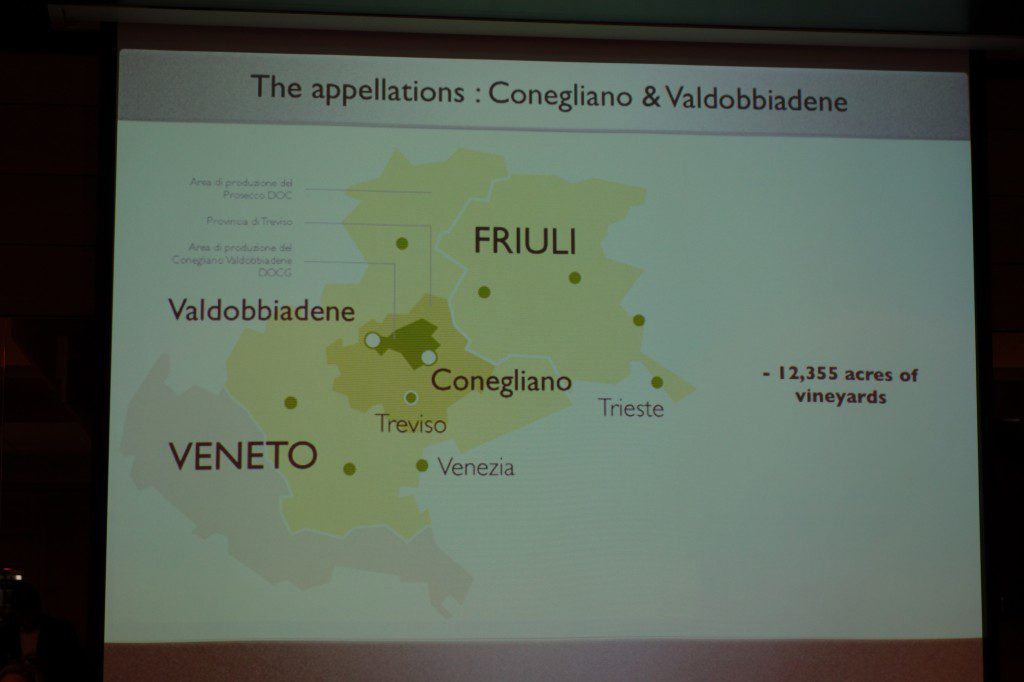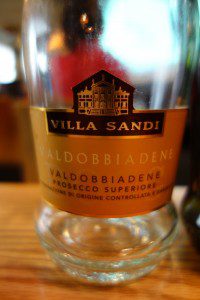14 Jun Italian Wine Focus: Prosecco
Seminar 2: Prosecco
If there is anything to remember here, it’s this:
Champagne is a Sparkling Wine but not all Sparking wines are Champagne. Champagne must be from the Champagne region is France.
Prosecco is a Sparkling wine but not all sparkling wines are Prosecco. Prosecco can only be from Veneto and Friuli in the north of Italy.
Prosecco has been a misused term. It has come to mean any sparkling wine from Italy made in the Charmat Method. But this is not correct. Prosecco is a grape; it is an area. It is more than a style. It has a terroir, a place, a history. Not to be mistaken for Champagne, Prosecco is bright and fresh. It is a perfect aperitif wine. And, Prosecco is Italy’s number one export!
Prosecco dates back to 1750 and but wasn’t introduced to the US until 2000. From 2005-2010, there was a 73.1% increase in imports to the US. In fact, in 2010 alone, 2.58 million cases of Prosecco were imported to the US.
Prosecco is not a type of wine; Prosecco is a varietal (also known as Glera, the ancient name for the grape). Prosecco is only made in the Charmat method (fermentation happens in tank) because the aroma is lost when made by Methode Champenoise. It can be made Sparkling, Frizzante or Fermo (still). Most importantly, Prosecco can only come from certain parts of Northern Italy, Friuli and Veneto to be exact.
VENETO VS FRIULI
The provinces that Prosecco can come from are Treviso, Belluno, Venezia, Padova and Vicenza Pordenone in Veneto and Udine, Gorizia and Trieste in Friuli. While Prosecco can only come from Veneto and Friuli, both regions like to take credit for Prosecco. Prosecco seems to have taken its name from the town in Friuli but Veneto is responsible for making the name known. The towns of Valdobbiadene and Cogniliano offer the two best expressions of Prosecco.
APPELLATIONS:
Conegliano and Valdobbiadene
Prosecco Cru Cartizze (1 commune)
DOCG Conegliano Valdobbiadene (15 communes) and DOCG Asolo (17 communes)
DOC Prosecco (555 comunes) and DOC Prosecco di Treviso (95 communes)
DOCG – made up of 2 villages. This is the qualitative and commercial heart of the grape/wine.
‘Rive’ on the label means must be hand harvested, low yields, single vineyards/village, only sparkling. May have a single vineyard mention
THE GRAPE: GLERA/PROSECCO
Prosecco/Glera ranks 13th in productions out of Italy’s 3000+ grapes. In 2008 there were 170 million bottles of Prosecco produced. A semi-aromatic varietal, Prosecco/Glera always has notes of pear, golden apple and sweet almonds. The grapes, which grow in long pointed clusters and produce medium sized berries with a thin dotted skin ripens in the first two weeks of October.
STYLES OF PROSECCO
The best producers’ wines are 100% Glera but according to the law, the wine must be at least 85% Glera (Prosecco) and can be up to 15% Bianchetta, Verdiso and Chardonnay added. Most Proseccos are NV (non-vintage). To make a vintage Prosecco, 85% of the grapes must come from that single vintage.
Tranquillo – This is a still wine. This style is less known and has a slight maceration on the skins. It is good for pairing with seafood.
Dry – This style is actually quite sweet and mostly found in the Cartizze subzone. With more intense fruit, there is higher residual sugar content and thereby lower alcohol.
Extra Dry – With higher residual sugar, this is the most popular style and great for aperitif or to pair with food.
Brut – This drier style is the most modern and international style.
This particular seminar, hosted by Diego Meraviglia from the North American Sommelier Association, featured the wines of Villa Sandi and special guest Laura Dassie. Family-owned and run Villa Sandi is located in Treviso, between the D.O.C.G. area of Prosecco Valdobbiadene and the D.O.C. area of the Montello and Piave wines.
Prosecco DOC Treviso Il Fresco (11% alc)
Very pale straw yellow and fine, persistent perlage; Aroma is fruity and flowery with hints of ripe golden apple and small mountain flowers, fresh pear, golden apple; Flavor is dry and fresh, followed by fruity aftertaste
Valdobbiadene Prosecco Superiore DOCG (extra dry style) (11% alc)
Very pale straw yellow and fine persistent perlage; Intensely fruity aroma with clear hints of ripe golden apple. Pleasant and elegant flowery sensation reminiscent of acacia flowers. Fresh, slightly sweetish and soft to the palate. Compared to the first wine, you get more minerality (limestone soils of the area)
Prosecco di Conegliano DOCG
Warmer and more exposed area. Yields are softer and creamier wines (due to higher sugars and lower acidity in the grapes); Soils are denser (more clay and calcium), wines are bigger and have more structure
Prosecco di Valdobbiadene DOCG
Bigger production than Conegliano. Cooler and less exposed, making drier crisper wines. Higher hills, thinner soils, lighter, less structured wines but more intensity on nose and more elegance
Conegliano Valdobbiadene Prosecco Cartizze DOCG
Within the commune territory of Valdobbiadene, the hills of Cartizze give name to the subzone (CrU) that is only 250 acres large. The balanced microclimate (uniform ripening) and very rich soil (morainic, clay, sandstone, marine fossils) make the wines more intense, more complex, more structured. The Prosecco Cartizze is usually found “dry” (paired with desserts) but can also be found brut.
Rosato il Fresco (80% Glera and 20% pinot noir) (11.5% alc)
Even though this wine is 80% Prosecco, by law you cannot call it prosecco; this is a Sparkling Rose. Light and bright rose; Fruity and flowery with delicate notes fo unripe folen apple and small mountain flowers; Dry, fresh and zesty, with a fruity and harmonious aftertaste
Discover more from Please The Palate
Subscribe to get the latest posts sent to your email.








